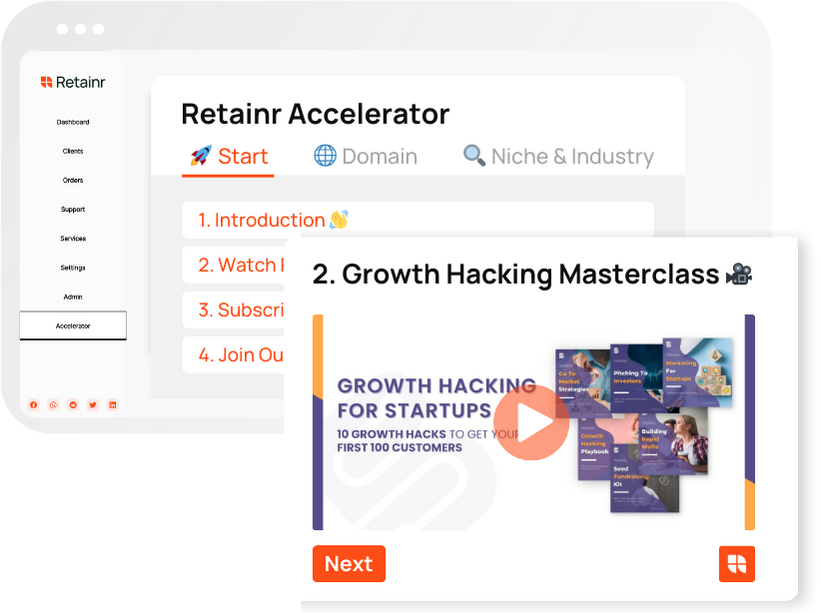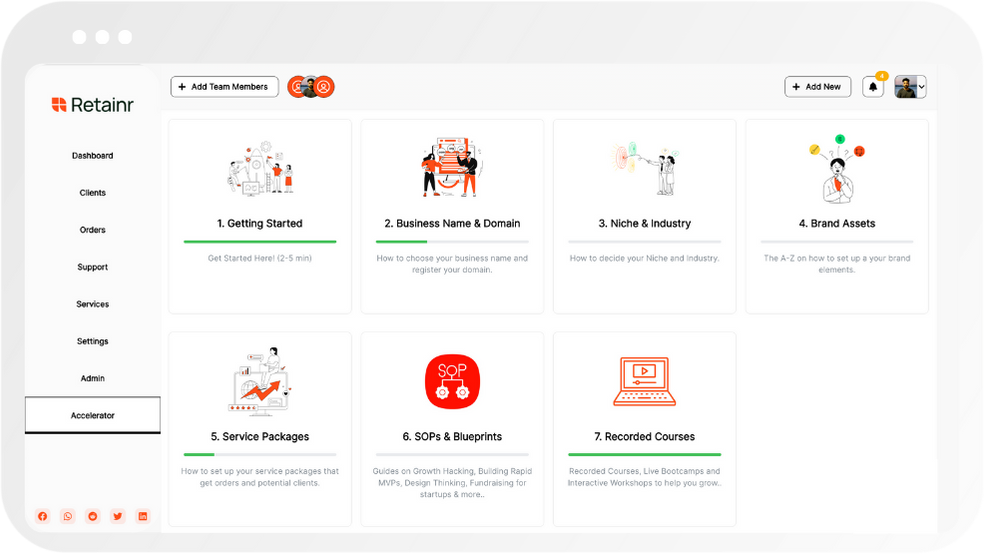
How to Implement a Data-Driven Social Media Marketing
Build with Retainr
Sell your products and services, manage clients, orders, payments, automate your client onboarding and management with your own branded web application.
Get Started1. What is data-driven social media marketing?
Understanding Data-Driven Social Media Marketing
Data-driven social media marketing has reshaped the way businesses interact with their target customers. This involves using specific insights derived from statistical data analysis to optimize your social media strategy. For instance, information on users’ online behaviors, preferences and engagement with your posts are used to influence future marketing decisions.
Key Elements in Data-Driven Social Media Marketing
- Audience Analysis: Identifying your target audience and understanding what they like helps to create content that resonates with them. Useful data points include demographic information like ages, location, interests, and online behavior.
- Competitor Analysis: By looking at what works well for your competitors, you can shape your strategy to be more effective. See what content gets them the most engagement, or where they lack, and orient your approach accordingly.
- A/B Testing: This involves creating two different versions of an advert or a post and monitoring the one that performs better. From this, you can glean useful insights on the type of content that works best for your audience.
The Significance of Data in Social Media Marketing
| Significance | Explanation |
|---|---|
| Optimized Content | Using data to understand what resonates with your audience means you can create content they are more likely to interact with. |
| Improved Targeting | Data allows for better demographic understanding of your audience, allowing you to target your social media campaigns more accurately. |
| Enhanced Engagement | Understanding what your audience prefers helps optimize the timing and frequency of posts, potentially leading to increased engagement. |
2. How do I implement a data-driven approach to social media marketing?
Creating and Executing a Data-Driven Social Media Marketing Plan
The implementation of a data-driven social media marketing approach begins by setting achievable objectives and goals. Generate key performance indicators (KPIs) to measure your success. Typical social media KPIs include follower count, engagement rate, click-through rate, likes, shares, and retweets. The specific data types you should track will depend on your goals.
Create data collection methods, which might include:
- Using platform-native analytics tools like Facebook Insights or Twitter Analytics
- Using social media management tools like Buffer or Hootsuite
- Implementing Google Analytics for tracking web traffic from social media
- Running customer surveys to get feedback and consumer insights
After collecting the data, use it to draw insights and then optimize your strategies accordingly:
- Analyze the data for patterns and trends. Which content types get the most engagement? What are the best times to post? Which audiences engage the most?
- Use this information to adjust your content, posting frequency, and targeting methods.
- Continue improving and iterating on your strategy based on your data findings
Example: Analyzing Data and Adjusting Strategies
An example analysis might look like the below table:
| Platform | Post Type | Average Engagement Rate | Action Taken |
|---|---|---|---|
| Image | 2.5% | Post More Images | |
| Link | 1.2% | Post Less Links | |
| Video | 4.3% | Post More Videos |
The table displays average engagement rates for various post types across three different platforms. From this data, we can deduce that videos on Instagram yield high engagement and should be utilized more often. Conversely, links on Twitter are not performing well and their usage should be reduced.
3. What are the key benefits of using a data-driven approach in social media marketing?
Key benefits of using a data-driven approach in social media marketing
Utilizing a data-driven approach in social media marketing provides a plethora of benefits that significantly improve the effectiveness of the overall strategy. Some of these key benefits include:
- Enhanced Customer Insights: Using data allows you to better understand your customer behavior and preferences. It helps marketers to tailor their content and strategies based on a solid understanding of their audience’s needs and wants.
- Improved Decision Making: Data-driven social media marketing removes guesswork and enables marketing teams to make informed decisions. Using detailed metrics and data, you can decide which strategies are performing well, and which ones need adjustment.
- Increased ROI: With data-driven insights, businesses can optimize their social media ad spend, target their audience more effectively and hence, increase the ROI.
These are merely a few of the key advantages of using data-driven social media marketing. The table below highlights these and other critical benefits along with a brief description.
| Benefit | Description |
|---|---|
| Enhanced Customer Insights | Data-driven marketing provides a deeper understanding of the consumer based on their online behavior, interests, and engagements. Marketers can use this data to tailor content specific to their audience's preferences, leading to increased engagement. |
| Improved Decision Making | Data eliminates the often costly guesswork associated with marketing campaigns. Marketers can base their decisions on solid information, helping to increase the effectiveness of their strategies and ultimately, the success rate of their campaigns. |
| Increased ROI | Accurate data analysis allows businesses to identify which strategies are working, allocate resources more efficiently, and assess the return-on-investment (ROI) more precisely, thereby boosting the overall profitability. |
4. How important is data analysis in creating a social media marketing strategy?
The Significance of Data Analysis in Social Media Marketing Strategy
Data analysis plays an indispensable role in formulating an effective social media marketing strategy. It provides critical insights on consumer behavior, market trends, and campaign performance, necessary for decision-making processes. Consequently, understanding your audience, optimizing your content, and driving your business's growth becomes more efficient and targeted.
Here are the primary reasons illustrating the importance of data analysis:
- Understanding the audience: Data analytics enables you to comprehend your audience better, highlighting their interests, demographics, and engagement patterns. Such insights help shape your content to match your audience's preferences.
- Optimizing the content: Through data analysis, you can determine the type of content your audience resonates with, the best times to post, and on which platforms they are most active. This information allows you to tailor and distribute your content effectively.
- Measuring performance: Data analysis provides a clear perspective on your campaign’s performance, helping you assess whether your current strategies are working or if adjustments are needed. Additionally, it facilitates the tracking of ROI.
Data Analysis Elements in Social Media Marketing Strategy
The key data elements to consider when creating a social media marketing strategy include audience demographic data, engagement data, and conversion data. Below is a tabular representation of these vital elements:
| Data Element | Description |
|---|---|
| Audience Demographic Data | This includes data such as age, gender, location, and language which helps in tailoring content to the target audience. |
| Engagement Data | This encompasses likes, comments, shares, retweets, and mentions, providing an understanding of how the audience interacts with the content. |
| Conversion Data | This reflects the number of actions taken like website visits, downloads, purchases, and sign-ups, pointing towards the success of the marketing strategy. |
5. What types of data should I consider when creating a data-driven social media marketing plan?
The Types of Quantitative Data
In a data-driven social media marketing plan, several types of quantitative data are typically considered. They provide tangible, measurable metrics. Some examples include:
- Engagement rate: The number of engagements (likes, comments, shares, etc) your posts receive.
- Reach: The number of unique users who see your post.
- Impressions: The number of times your post is displayed, irrespective of clicks or user engagement.
- Click-Through Rate (CTR): The percentage of users who click on your posted links out of the total number who viewed the post.
- Follower Demographics: Relevant aspects such as location, age, gender, interests and others.
Qualitative Data to Consider
Apart from these measurable metrics, qualitative data is also crucial for understanding user behavior and preferences. These are harder to measure and typically involve:
- Sentiment Analysis: Understanding the audience's feelings towards your brand or posts.
- Comments and Reviews: Qualitative feedback from your audience can provide crucial insights about their preferences.
- Campaign performance: Comparing various campaigns to understand what kind of content garners more engagement and positive sentiment.
Data Compilation
Collating these qualitative and quantitative data effectively gives a comprehensive view of the success of your marketing efforts. This can be arranged in a table for easier comprehension and comparison.
| Metrics | Quantitative Data | Qualitative Data |
|---|---|---|
| Engagement | Number of likes, comments, shares, etc | Positive/Negative sentiment |
| Reach and Impressions | Number of unique views and total views | Comments and shares |
| Click-Through Rate | Percentage of users who clicked the links | User feedback and reviews |
| Follower Demographics | Age, location, gender, etc | Interests, preferences, etc |
6. How can data-driven social media marketing improve engagement and conversion rates?
Benefits of Data-Driven Social Media Marketing
A major advantage of leveraging data-driven social media marketing is the potential improvement in engagement and conversion rates. Data gives you detailed insights about your audience, allowing you to target them more effectively and deliver content that resonates. This typically leads to increased engagement and, ultimately, a higher conversion rate.
Effective Targeting & Personalization
A data-driven approach enables you to:
- Identify the demographics of your audience, which could include their age, gender, location, interests, and their overall interaction with your brand.
- Understand optimal times to post for maximum engagement based on your audience behaviour.
- Personalize content based on user viewing habits and preferences, significantly increasing engagement rates.
Performance Metrics & Data Tracking
By implementing a data-driven social media strategy, you can use performance metrics and data tracking to improve your conversion rates:
| Metric | Description |
|---|---|
| Click-Through Rate (CTR) | This indicates how many people click on your post or ad, signalling immediate engagement with your content. |
| Conversion Rate | This measure shows how many of the people who clicked on your post or ad actually made a purchase or completed a desired action. |
| Customer Acquisition Cost (CAC) | This tracks how much you’ve spent acquiring new customers through your social media marketing efforts, helping to establish if your investment is paying off. |
7. What tools or software can I use to gather and analyze data for social media marketing?
Tools for Gathering Social Media Data
The digital market offers a variety of software and tools that can assist in collecting valuable data for your social media marketing. Some of the predominant tools include:
- Google Analytics: This tool offers valuable insights about your website traffic and the performance of your content on social media platforms.
- Brandwatch: You can use this to monitor your brand's health, analyze your audience, and manage your online reputation effectively.
- Facebook Insights: It is specifically designed for Facebook and provides in-depth data about user interaction and engagement on your posts.
- Twitter Analytics: This platform-specific tool provides useful data about your tweets, audience demographics, and engagements.
- Hootsuite: This tool supports data gathering across a variety of social media sites and helps you monitor your social media presence effectively.
Software for Analyzing Social Media Data
Analyzing social media data can be as critical as gathering it. You can use the following software for effective analysis:
- Brand24: This application provides real-time social media monitoring and analysis, helping you to react promptly to social media interactions.
- Socialbakers: This AI-powered tool provides audience analysis, content intelligence, and competitive intelligence analytics.
- SEMRush: Offers SEO, PPC, content, social media and competitive research analysis.
- Sprout Social: An all-in-one social media management tool provides deep analytics with detailed reports.
- Tableau: Popular in data visualization, Tableau can create easy-to-understand graphs and figures from your social media data.
Utilizing tools and software for data-driven marketing
| Tool/Software | Gathering Data | Analyzing Data |
|---|---|---|
| Google Analytics | Yes | Yes |
| Brandwatch | Yes | Yes |
| Facebook Insights | Yes | No |
| Twitter Analytics | Yes | No |
| Hootsuite | Yes | Yes |
| Brand24 | No | Yes |
| Socialbakers | No | Yes |
| SEMRush | No | Yes |
| Sprout Social | No | Yes |
| Tableau | No | Yes |
The categorization above provides a guide on how to select software and tools based on your primary needs. However, a combination of these tools will most often yield the best results for data-driven social media marketing.
8. Can you give examples of successful data-driven social media marketing strategies?
Success Stories of Data-Driven Social Media Marketing
Data-driven social media marketing strategies have revolutionized the way businesses advertise and connect with their audience. They enable businesses to make informed decisions based on valuable insights from consumer data. Here are some compelling examples of companies that have achieved significant gains by leveraging data-driven social media marketing strategies:
- Netflix: The global streaming giant leveraged data analytics to create a marketing strategy for its blockbuster, House of Cards. The company used data from customer behavior, preferences, and social media engagement to understand what their audience wanted. By analyzing the consumers' data, such as what they watched, paused, or skipped, Netflix crafted its promotional campaigns that resulted in a massive success.
- American Express: American Express used predictive modeling to analyze social media conversations for its 'Small Business Saturday' campaign. They specifically targeted users who would be most likely to respond positively. The campaign resulted in millions of uses of their hashtag and significant boost in sales.
- Dunkin Donuts: Dunkin Donuts used a data-driven approach to launch a new mobile app using feedback and data from social media. They integrated customer feedback into the app’s development and architecture, leading to increased customer usage and retention.
Key Metrics for Successful Data-Driven Social Media Marketing
The mentioned success stories illustrate how leveraging key metrics is pivotal to executing top-notch data-driven social media marketing strategies. Some of these critical metrics include:
| Key Metrics | Description |
|---|---|
| Social Shares/Likes | Measure the virality of your content |
| Conversion Rate | Percentage of users who take a desired action |
| Return on Investment (ROI) | Measures the return on the investment you made in your marketing campaign |
| Bounce Rate | Percentage of people who visit your website and leave without viewing other pages |
Utilizing Data For Customizable Marketing Approaches
The power of data-driven social media marketing lies in its ability to enable businesses to create customizable marketing approaches that effectively sway targeted consumer behavior. By tracking user engagement metrics such as likes, shares and overall reach, businesses can personalize their offerings to forge deeper connections with their customers, delivering relevant content that resonates with their needs and preferences. An excellent example of this would be Amazon's recommendation system, which is based on users’ past purchases and browsing history to suggest new products, driving better user engagement and increased sales.
9. How can I measure the success of my data-driven social media marketing?
Identifying Key Performance Indicators
One way to evaluate the effectiveness of your data-driven social media marketing is by identifying and tracking Key Performance Indicators (KPIs), which are quantifiable measurements to define success. Social media KPIs might involve engagement rates (likes, shares, comments), follower growth, website traffic, and conversion rates. Here is a brief list of potential KPIs:
- Reach: Total number of unique visitors who have seen your post or profile.
- Engagement: The sum of interactions that include likes, shares, and comments.
- Impressions: The total number of times a post has been displayed.
- Click-through rates (CTR): The percentage of people who clicked on your link.
- Conversion rate: The proportion of visitors who take a specific action like making a purchase, signing up for a newsletter, etc.
Using Analytics Tools
By utilizing analytics tools, businesses can get insights into the metrics that matter most to their marketing goals. Social media platforms themselves provide built-in analytical tools that reveal valuable data about your audience and how they engage with your content. Applications like Google Analytics, Hootsuite, and Sprout Social can offer more detailed insights. Below is a table highlighting the features of these three popular tools:
| Tool | Features |
|---|---|
| Google Analytics | Tracks website traffic, user behavior, conversion funnels |
| Hootsuite | Manages and schedules posts on multiple platforms, measures performance, monitors conversations |
| Sprout Social | Offers social listening, publishing, analytics, and engagement feature |
Running A/B Tests
A/B testing is another method which means comparing two versions of aspects of your social media content to see which one performs better. It can be used to test everything from post formats (video vs. image) to post times (morning vs. afternoon). You can try the following:
- Rotate Ad creative: Test different visuals, headlines, captions, and CTAs.
- Segment audience: Divide your audience into subgroups based on their demographics, behaviors or interests, and pitch slightly different ads to each group.
- Time and Days: Test posting content on different days and at different times.
10. What are some common mistakes to avoid when implementing a data-driven social media marketing strategy?
Common Mistakes to Avoid
When implementing a data-driven social media marketing strategy, it's easy to fall into some common pitfalls if you're not careful. By avoiding these typical mistakes, you can increase your strategy's potential to drive meaningful results for your business:
- Ignoring the Quality of Data: It's essential to ensure the data you're using is accurate and reliable. Using poor quality data can lead to misguided strategies and ineffective results. Always check your data sources and verify their credibility.
- Not Having a Clear Goal: Without defined objectives, it's impossible to measure success. Ensure you have specific, quantifiable goals that align with your business needs.
- Not Adjusting Strategy Based on Insights: The purpose of a data-driven strategy is to use the data to make informed decisions. If you're not adjusting your strategy based on the insights your data is giving you, you're not efficiently utilizing your data.
Importance of Avoiding Mistakes
Avoiding these common mistakes can save your organization time, resources, and ensure your social media efforts are maximized. The table below elaborates on why avoiding these mistakes is vital for a successful social media marketing strategy.
| Mistake | Impact |
|---|---|
| Ignoring the Quality of Data | Can lead to misinformed strategies and loss in investment. |
| Not Having a Clear Goal | Without tangible targets, measuring success is impossible. |
| Not Adjusting Strategy Based on Insights | Failing to react to insights can result in missed opportunities. |
How to Avoid These Mistakes
To avoid these common mistakes, here are a few straightforward steps that any organization can adopt:
- Validate Your Data: Always cross-check your data from multiple sources to ensure its accuracy.
- Establish Clear Goals: Understand what you want to achieve through your social media marketing. Have specific, measurable, achievable, realistic, and time-bound (SMART) goals.
- Be Responsive to Data: Continually analyze your data and be ready to tweak your strategy based on the insights you gather.
Conclusion
Drive Your Social Media Marketing with Data
In today's hyperconnected world, leveraging social media platforms for marketing and sales growth is essential. Simply creating accounts and sending out intermittent posts is no longer sufficient. Your strategy needs to be data-driven, and you need to have a software that can help you process and make sense of that data.What is a Data-Driven Social Media Marketing Approach?
A data-driven approach to social media marketing involves using data and insights garnered from your social interactions and campaigns across different platforms to optimise your strategies. This includes analysing demographics, engagement rates, best-performing content, and other metrics that can inform your future decisions.How to Implement Data-Driven Social Media Marketing?
To implement a data-driven social media marketing strategy, you must go beyond just collecting data. 1. Identify Your Key Performance Indicators (KPIs): Determine what metrics matter to your brand. These could be likes, shares, comments, page views, conversion rates, etc.2. Collect Data: Use analytics tools on social platforms to collect data related to your KPIs. 3. Analyse and Interpret Your Data: Look for trends, peaks, and drops - they will point you in the direction of what works and what doesn't.4. Implement Changes: Use the information gathered to tweak your strategy.5. Measure Again: After implementation, measure your results again to see if the changes led to improvement.The Role of Retainr.io in Your Marketing Approach
The process may seem overwhelming, especially if you have multiple social media platforms to track. This is where Retainr.io can help. Retainr.io is a white-label software that allows you to sell, manage clients, orders, and payments with your own branded app. It is designed to streamline the data management and analysis process for your social media interactions. With Retainr.io, you can track your KPIs, analyse trends, and strategise effectively. Implementing a data-driven social media approach can propel your brand to higher levels of engagement and conversions. With the help of Retainr.io, this process becomes more straightforward and effective. Get started today to experience the difference.Boost Your Agency Growth
with Retainr Accelerator
Uncover secrets, strategies, and exclusive blueprints to take your agency's growth to the next level — from marketing insights to effective presentations and leveraging technology.

SOPs, Cheatsheets & Blueprints
Leverage 50+ SOPs (valued over $10K) offering practical guides, scripts, tools, hacks, templates, and cheat sheets to fast-track your startup's growth.
Connect with fellow entrepreneurs, share experiences, and get expert insights within our exclusive Facebook community.
.jpg)

Join a thriving community of growth hackers. Network, collaborate, and learn from like-minded entrepreneurs on a lifelong journey to success.

Gain expertise with recorded Courses, Live Bootcamps and interactive Workshops on topics like growth hacking, copywriting, no-code funnel building, performance marketing and more, taught by seasoned coaches & industry experts.

.jpg)

.jpeg)


